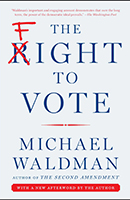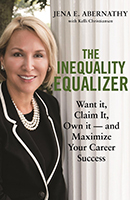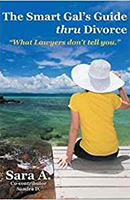 Verdict: Touchdown!
Verdict: Touchdown!
The Fight to Vote
By Michael Waldman (New York, NY: Simon & Schuster, 2017). 400 pgs. $18. Order, www.simonandschuster.com.
Reviewed by Craig R. Johnson
The Fight to Vote, by Michael Waldman, is a detailed history of populist movements to expand the franchise in the United States, from the revolutionary period through the 2016 elections.
Waldman is president of the Brennan Center for Justice at the New York University Law School; as a scholar-activist, he is clearly in favor of expanding voter participation. He starts by examining who was able to vote in the earliest elections of the new United States. He details the struggle to expand voting rights beyond those people who traditionally voted in the 13 original colonies – that is, property-owning white men.
Want to Review a Book?
Please request a book and writing guidelines from Wisconsin Lawyer managing editor Karlé Lester, at klester@wisbar.org or (608) 250-6127. Reviewers may keep the book reviewed. Reviews of about 500 words are due within 45 days of receiving the book. Reviews are published, space permitting, in the order received and may be edited for length and clarity.
Resistance to expansion was widespread, as exemplified by John Adams in a letter addressing voting qualifications in a new constitution for Massachusetts: “There will be no end of it. New claims will arise. Women will demand a vote … and every man, who has not a farthing, will demand an equal voice with any other in all acts of state.” Nonetheless, they persisted – and slowly the franchise expanded.
In later chapters, Waldman details the extension of voting rights through five separate constitutional amendments over two centuries – the 15th (guaranteeing the right to African-American men formerly enslaved), the 17th (direct election of U.S. Senators), the 19th (women), the 24th (outlawing poll taxes), and the 26th (18 year olds’ right to vote).
One consistent theme is the swinging pendulum regarding which party or interest group backed expansion of the franchise. For example, in the early 1800s the Democratic Party fought to expand the franchise to help Andrew Jackson in his war against central banking and entrenched economic power. After 1865, of course, the southern-dominated Democratic Party led the fight against expanding electoral power to newly freed African Americans.
Later chapters critique contemporary assaults on the Voting Rights Act and other efforts to limit the vote via voter ID laws and challenges to expanded hours at polling places. Waldman details efforts throughout the country to systematically curtail, for partisan gain, voter turn-out in communities in which many low-income and minority-group individuals reside. He notes the finding by the trial court in Wisconsin’s voter ID case, Frank v. Walker, that 300,000 registered voters lacked proper identification under the law – in a state Trump later carried by 27,000 votes. Waldman highlights Judge Posner’s dissent from the Seventh Circuit decision to reverse the trial court in Frank, noting Posner’s characterization of some evidence of voter fraud as “downright goofy, if not paranoid.”
Waldman’s book is an information-packed and inspiring tale of efforts over two centuries to expand the franchise – the “fight to vote.” These efforts have run into trouble recently as populist movements, traditionally interested in expanding voting rights, have become a collective cudgel to beat them back. Nonetheless, despite the “unsettling new era of American politics” ushered in by the 2016 election, the fight to expand American democracy will continue.
Craig R. Johnson, U.W. 1994, practices criminal defense and labor law in Milwaukee at Sweet and Associates.
 Verdict: It’s a Keeper
Verdict: It’s a Keeper
The Inequality Equalizer: Want It, Claim It, Own It – and Maximize Your Career Success
By Jena E. Abernathy (Chicago, IL: ABA Ankerwycke Publishing, 2016). 327 pgs. $22.50 (ABA members). Order, https://shop.americanbar.org/eBus/publications.aspx.
Reviewed by Farheen M. Ansari
The Inequality Equalizer caters to a very specific group of readers: young women entering the corporate business field. Abernathy starts each chapter with a short email to her mentee “Megan” to lay out the next topic. I’m not within Abernathy’s target audience, but I nevertheless found myself able to relate to many of the issues discussed and benefited from the lessons in each chapter. I was easily able to apply the corporate real-world examples to the legal world.
Although this book is written for a younger audience just embarking on their careers, it can be as helpful for those who are years into the work world. People who have recently switched work environments or those who want to change their current circumstances may find it especially useful. To provide a personal example, I started my own solo law practice right out of law school. I worked with other lawyers occasionally and had interns and paralegals, but it was a huge adjustment for me to join a district attorney’s office years later. There aren’t law school classes on office politics and social etiquette (at least when I was in law school), so one of the best ways to learn is to read “self-help work” books such as these.
For those lawyers who do not have access to a mentor at their firm or office, Abernathy steps into that role by talking directly to the reader. I have read numerous career guides throughout the years, and although I like some more than others, each book has brought at least one unique lesson or perspective. What was unique in The Inequality Equalizer was Abernathy’s overall theme of balancing your inner “junkyard dog” (the scrappy, hard-charging go-getter) with your “inner pedigree” (the polished, poised, advantaged professional). Young or new professionals might have great ideas to help their organization, but, Abernathy warns, if they are defensive and lacking practical skills to know how to present those ideas and how to act on them, it will be hard to be successful.
This is a well-organized book that gives each lesson its own chapter, teaches the lesson through real-world examples, contains headlines to highlight important points, and lists bullet points to review the lesson at the end of each chapter. The organizational structure makes it easy to go back to the book and read about a particular topic without having to re-read entire chapters. In that aspect, it’s structured like a textbook. The easily skimmable format should appeal to busy lawyers. Particularly useful is the appendix “An A-to-Z List to Leveling the Playing Field,” a brief four-page summary of all the various lessons and advice provided in the book. I am glad to add this book to my library and plan on reading it again.
Farheen Ansari, Marquette 2009, is an assistant district attorney in Harris County, Texas. She previously practiced criminal defense in Madison.
 Verdict: Not for Me, Maybe for You
Verdict: Not for Me, Maybe for You
The Smart Gals’ Guide thru Divorce: What Lawyers Don’t Tell You
By Sara A. (Bloomington, IN: WestBow Press, 2017). 149 pgs. $13.46. Order, www.amazon.com.
Reviewed by Rebecca L. Nelson
This book is a compilation of tips from the perspective of a person who has gone through divorce but is not a lawyer. I thought this would be an interesting choice because a few people have asked me for referrals for divorce lawyers, and I thought knowing a little more about divorce would be useful. I like the fact that this book discusses the divorce process from beginning to end, including before hiring a lawyer and after the process is over. The writer discusses the “human” aspect of divorce, not just the legal component.
This book gives insight from a layperson’s perspective, but I think it lacks some necessary sophistication. The text is written like a poem. The book’s stylistic components (layout, font) also are informal, which is distracting. However, the layout does provide space for notes, which may be helpful to some people using the book as a workbook. The book includes practical tips about staying organized, avoiding social media, being smart about finances, and parenting, which are considerations that might not be on a lawyer’s radar. Thus, this book provides good supplemental instruction for a person going through divorce who also has a lawyer.
The Smart Gal’s Guide thru Divorce is written from a religious perspective, which shifted the emphasis away from nitty-gritty tips about divorce. If I were going to recommend a divorce guide to a friend, I might not recommend this book because of the style of prose and somewhat distracting emphasis on religion. Certainly, religion and spirituality can be a source of comfort to a person sorting through a traumatic and emotional time. As a lawyer, however, I think the religious emphasis makes the writer seem less credible with regard to legal divorce knowledge and more credible with regard to spirituality. Spiritual references might be best suited for a nonfiction book or a book devoted entirely to coping with divorce.
I respect the effort of the writer, and it appears she is a motivational speaker, such that this book may be read best in conjunction with attending one of her presentations.
Rebecca L. Nelson, Marquette 2015, is a worker’s compensation defense attorney in Milwaukee.
